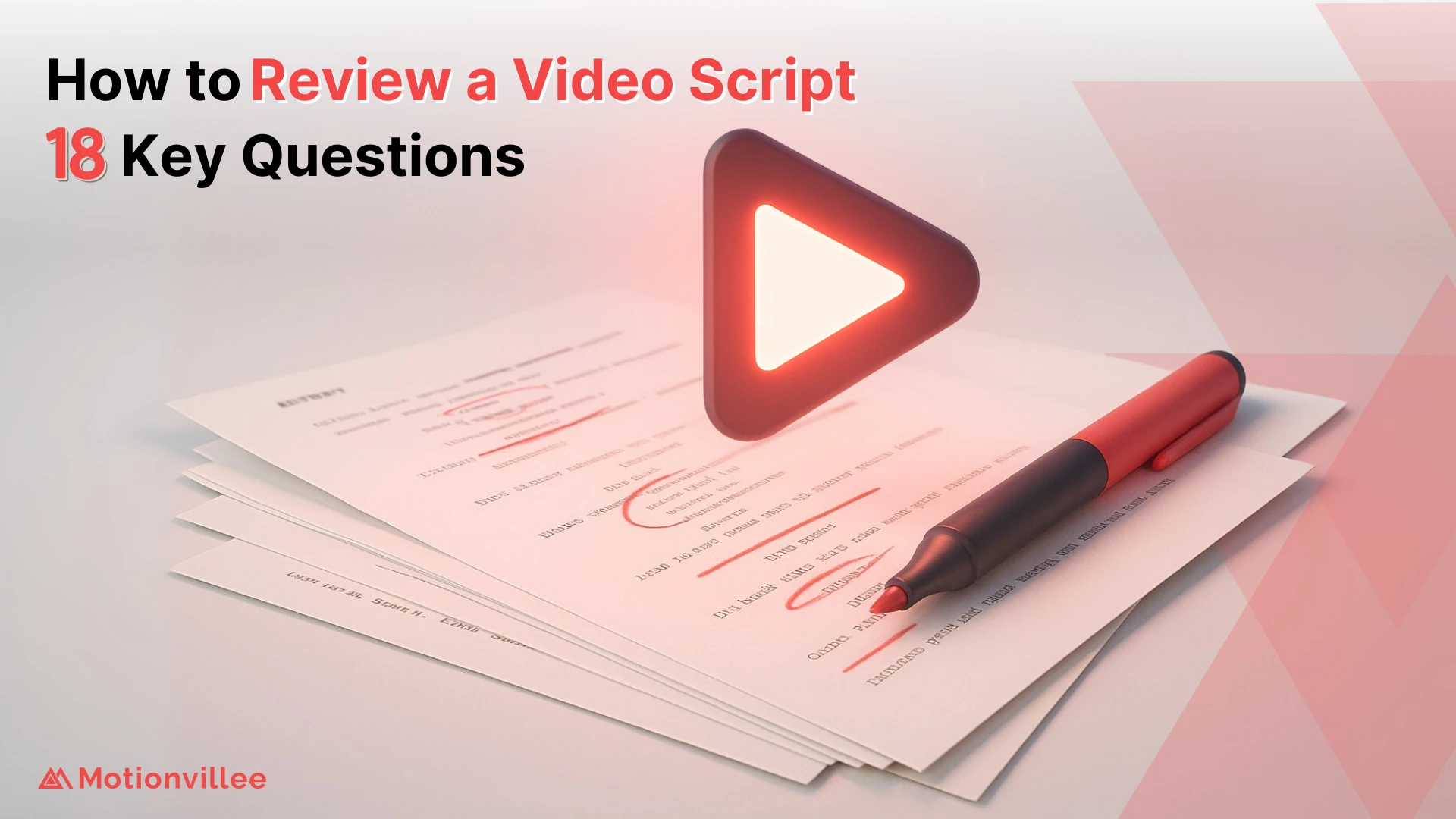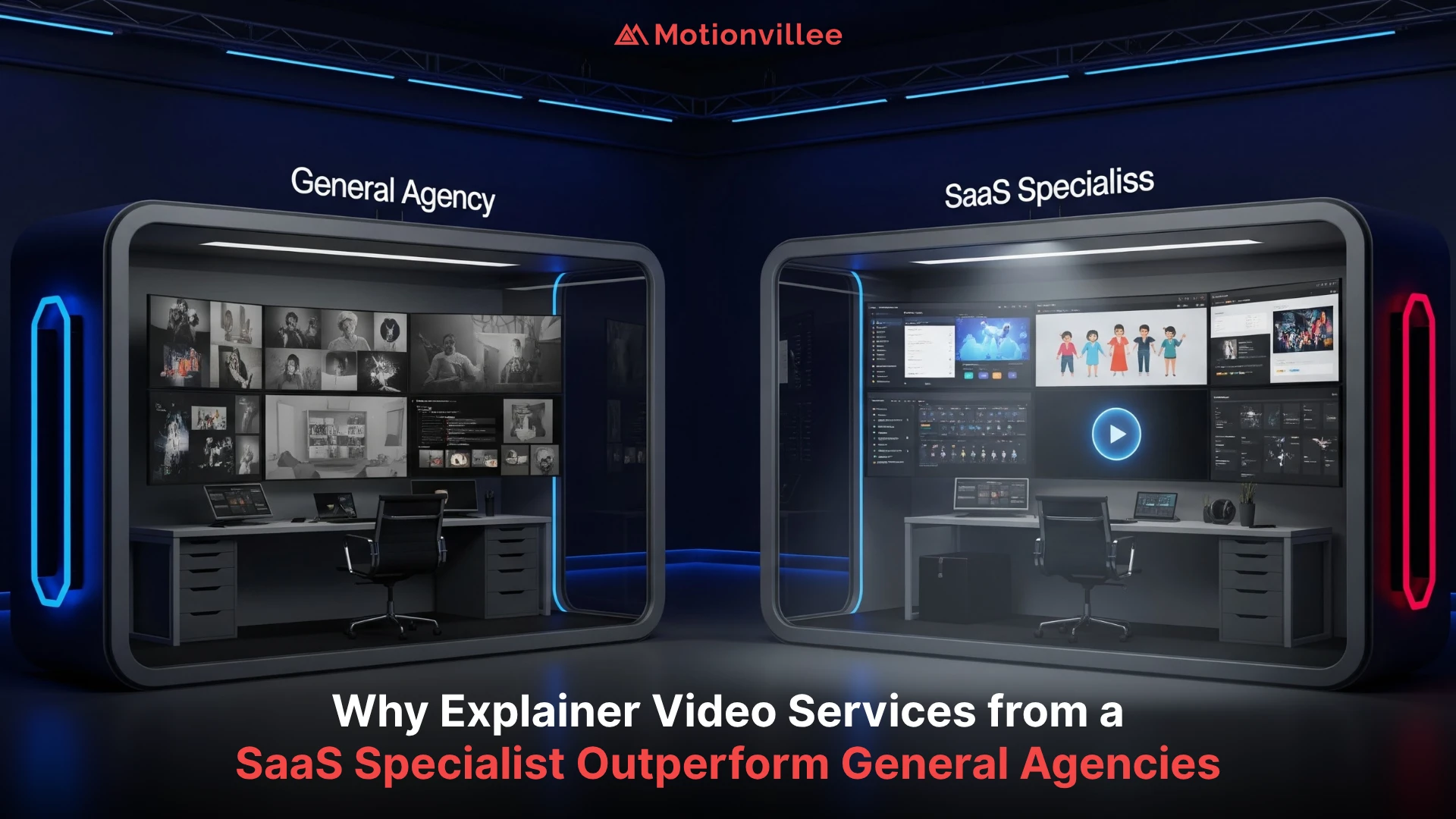Why Should You Ask Before Approving a Video Script?
You should Ask Before Approving a Video Script because it aligns your message with goals, protects your budget, and improves ROI.
A careful video script approval step prevents rework and weak outcomes. It confirms clarity, audience fit, and brand tone before you commit to production.
Use a simple review video script checklist to test message, pacing, and call to action. Partnering with experts in Explainer Video Production helps you validate these checks before any spend.
By asking the right questions to ask before video production, you set up a video that builds trust and drives measurable results.
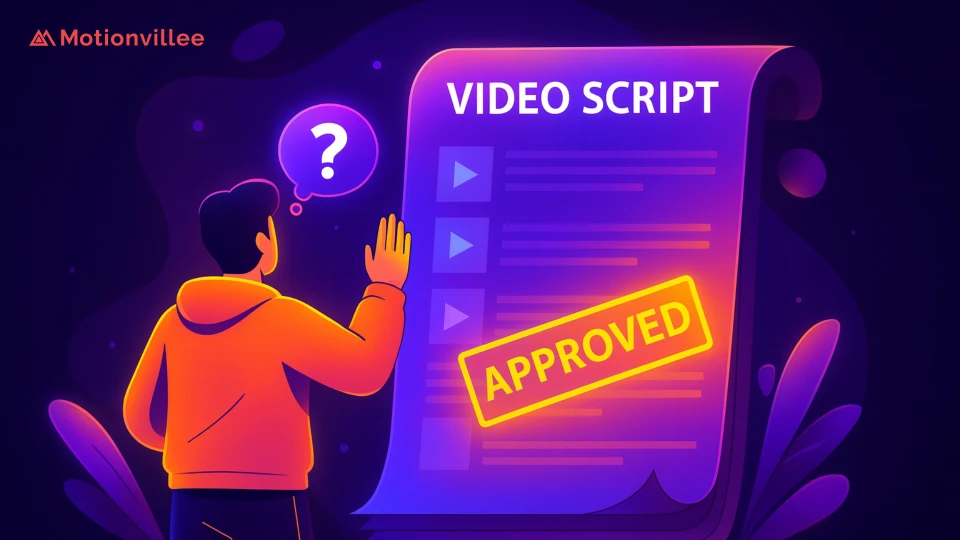
1. Does the script clearly define the target audience?
A video script that defines a specific target audience will always perform better than one that speaks too broadly.
When a video tries to address everyone, it ends up connecting with no one. Identifying the target audience for video scripts helps shape the right message, tone, and examples. A CFO expects data and efficiency, while a founder looks for growth-focused clarity. Matching audience to message is where Brand Explainer Video Production proves its value.
2. Is the main message easy to understand in under 30 seconds?
The main message should be clear within the first 30 seconds or you risk losing viewers.
Executives have limited attention spans. A clear video message upfront ensures they grasp the value quickly. If the benefit is buried in long explanations, engagement drops. Test this by reading the opening lines aloud, if the value is not obvious immediately, the script needs adjustment.
3. Does the script address a customer pain point directly?
Addressing a customer pain point makes the script more persuasive and relevant.
A script that solves a real problem earns attention faster than one that lists generic features. Decision-makers respond to solutions for challenges like high costs, slow adoption, or compliance risks. Embedding these pain points into the narrative makes the video more memorable and action-driven.
4. Is the tone and language appropriate for your brand?
Scripts written in a tone consistent with your brand build stronger trust.
The brand tone in videos should mirror how your company communicates across other channels. If your messaging is professional on your website but casual in the video, it creates confusion. Consistency reassures the audience and strengthens brand recognition.
5. Does the script open with a strong hook?
A strong opening hook is essential because it decides whether your audience keeps watching.
The first ten seconds must spark interest, whether through a surprising fact, a relatable problem, or a bold statement. If the opening feels generic, the viewer may exit before the core message appears. A hook does not need to be flashy, it needs to be relevant and clear.
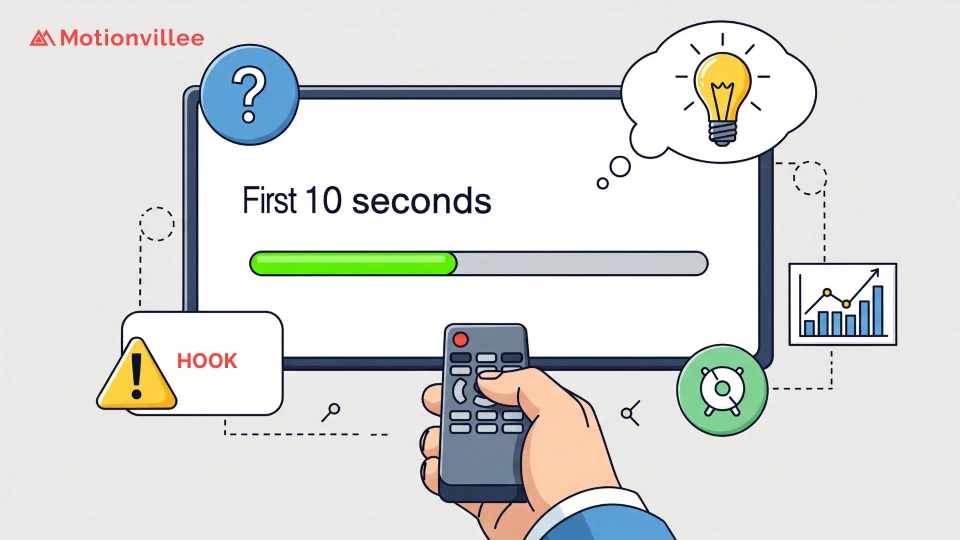
6. Is there a clear narrative structure (problem → solution → action)?
Scripts that follow a structured flow are easier to understand and more persuasive.
A strong video storytelling structure walks the audience through a clear journey. First, show the problem your audience faces. Then, position your product or service as the solution. Finally, guide them toward a specific action. This sequence makes information easier to recall and builds momentum for decision-making.
A scattered or random script, on the other hand, leaves viewers confused and disengaged.
7. Does the script keep sentences short and conversational?
Short, conversational lines improve retention and make the video easier to follow.
Long sentences and complex wording create barriers, especially when spoken aloud. A conversational script keeps attention by sounding natural and approachable. This is particularly important for decision-makers who process information quickly.
Review scripts by reading them aloud. If the sentences feel heavy or hard to say, they should be shortened. This is a simple way to boost engagement and clarity.
8. Is the length appropriate for the video format?
Matching script length to format ensures the message lands without overstaying its welcome.
For example, an explainer should run under two minutes, while a demo may need more depth. If the script tries to cover too much, pacing suffers and the audience loses interest. Asking “how long should a video script be” helps align duration with content type.
When planning a Product Demo Videos, remember that clarity matters more than word count. A concise, well-timed script can outperform a longer one that drags on.
9. Does the script tie back to business outcomes?
A script is only effective if it connects directly to measurable business outcomes.
Executives want to know how a video supports growth, sales, or customer retention. When reviewing, ask whether the narrative highlights ROI of video scripts such as higher lead conversions, stronger brand trust, or faster deal closures. Without this connection, the script may entertain but will not influence pipeline performance.
10. Is the call-to-action specific and measurable?
A strong call-to-action should guide the viewer toward one clear next step.
Generic CTAs like “learn more” or “contact us” lack urgency. Instead, the script should include a video call to action that is precise, such as scheduling a demo, downloading a case study, or booking a consultation. The action must also be measurable so its impact on conversions can be tracked.
Scripts that skip this step risk leaving viewers engaged but inactive.
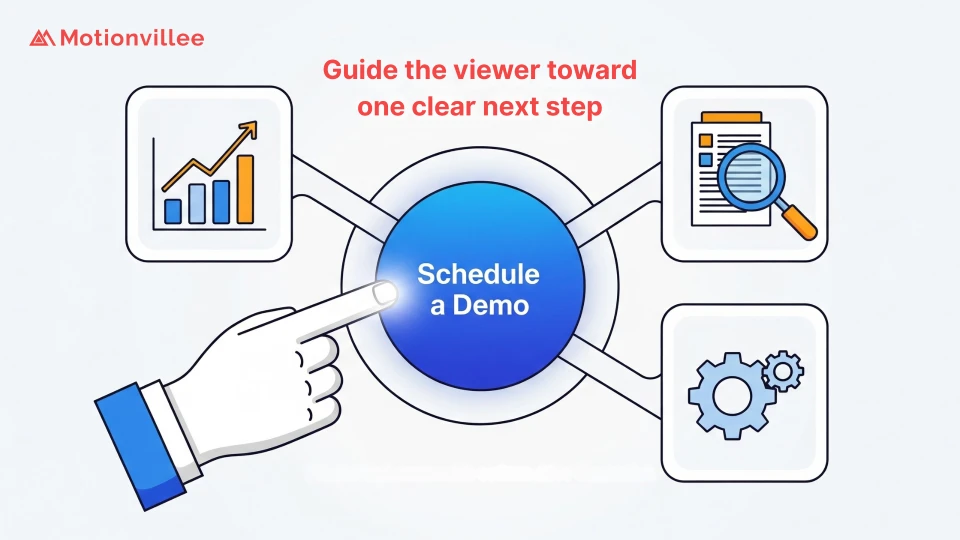
11. Does the script highlight competitive differentiation?
A script that shows what sets your business apart creates stronger positioning.
If every competitor claims “great service” or “reliability,” those points lose impact. The script should instead emphasize unique value drivers, for instance, speed of implementation, cost savings, or compliance expertise. Competitive clarity builds confidence and avoids blending into the noise of the market.
When integrated properly, these points shift the script from a simple story to a strategic tool.
12. Are product benefits explained more than just features?
Focusing on benefits makes the script persuasive, while features alone often fall flat.
Decision-makers care less about how a tool works and more about what it achieves for them. Instead of saying, “Our software tracks transactions,” say, “Our software reduces errors and protects revenue.” This switch from features to benefits keeps the message customer-focused.
Clarity in this area is especially critical for B2B Video Production, where videos are expected to prove business value. A script that emphasizes outcomes over technical details resonates more deeply with executives who prioritize ROI.
13. Is the script realistic for your production budget?
A script should always match the production budget to avoid overspending.
If the script demands elaborate sets, multiple locations, or high-end animations that exceed your resources, production delays and cost overruns are inevitable. A strong script balances ambition with what can be delivered on budget while still achieving impact. Reviewing early keeps expectations realistic.
14. Does the script specify visuals or leave room for creative direction?
The best scripts give direction but also allow creative teams flexibility.
Overly detailed visual instructions can limit innovation, while vague descriptions may confuse the production team. A good balance is to specify key visuals, such as product shots, charts, or customer scenarios, and leave stylistic choices open. This approach gives creative experts room to enhance the story without straying from intent.
15. Is the pacing aligned with visuals and voiceover delivery?
Good pacing ensures that the script and visuals work together seamlessly.
If sentences are too long, the voiceover may feel rushed, leaving visuals behind. If too short, the video may drag with unnecessary pauses. Scripts should be tested by reading them aloud while visual placeholders are considered. This practice highlights where timing adjustments are needed to maintain audience attention.
The right pacing is especially important for decision-makers, who prefer concise, efficient delivery.
16. Does the script avoid unnecessary technical jargon?
Clarity is more persuasive than technical jargon, even in B2B contexts.
A script filled with complex terms risks alienating viewers, especially non-technical executives who focus on outcomes rather than systems. Simplifying technical points into benefits ensures that the message is accessible. For example, instead of saying “AI-powered predictive algorithms,” you could say “tools that save time by forecasting demand accurately.”
Scripts that maintain clarity reach broader audiences and improve trust. This is one reason many brands rely on Corporate Videos to ensure the right balance between technical accuracy and viewer-friendly communication.
17. Have all stakeholders reviewed the script?
Scripts that receive early input from all stakeholders save both time and cost.
When finance, marketing, and compliance teams align before production begins, it prevents rework later. Each group brings a unique lens, finance checks budget alignment, marketing ensures brand consistency, and compliance validates messaging. Without this joint review, conflicting feedback can surface after production, leading to expensive revisions.
Encouraging collaborative approval at the script stage ensures smoother execution and stronger final output.
18. Does the script reflect your compliance or legal requirements?
Compliance checks must be built into the script approval process to protect brand reputation.
Missing a disclosure, overstating a claim, or using restricted terminology can create legal risks. The script should be reviewed with the same seriousness as a press release or financial report. This step is particularly vital in industries like fintech, healthcare, or cybersecurity where oversight is strict.
For growing companies, working with teams skilled in SaaS Videos helps balance creative storytelling with compliance safeguards. This keeps the video persuasive while staying within the boundaries of regulations.
Why Should You Ask Before Approving a Video Script?
Approving a script without asking the right questions can lead to wasted spend, weak messaging, and disappointing results. You should always Ask Before Approving a Video Script to confirm that it aligns with your goals, audience, and ROI expectations.
A well-reviewed script acts as a safeguard. It checks for clarity, brand consistency, pacing, budget fit, and compliance. Each question you ask during the review prevents mistakes that would otherwise surface only after production has started.
Think of these 18 questions as your script approval checklist. They help you see beyond the creative flow and evaluate whether the script will actually perform in the market.
By treating script approval as a strategic step, you protect your investment, strengthen your message, and ensure your video supports long-term business growth.
👉 Ready to explore your next project? Schedule a call with Motionvillee.


